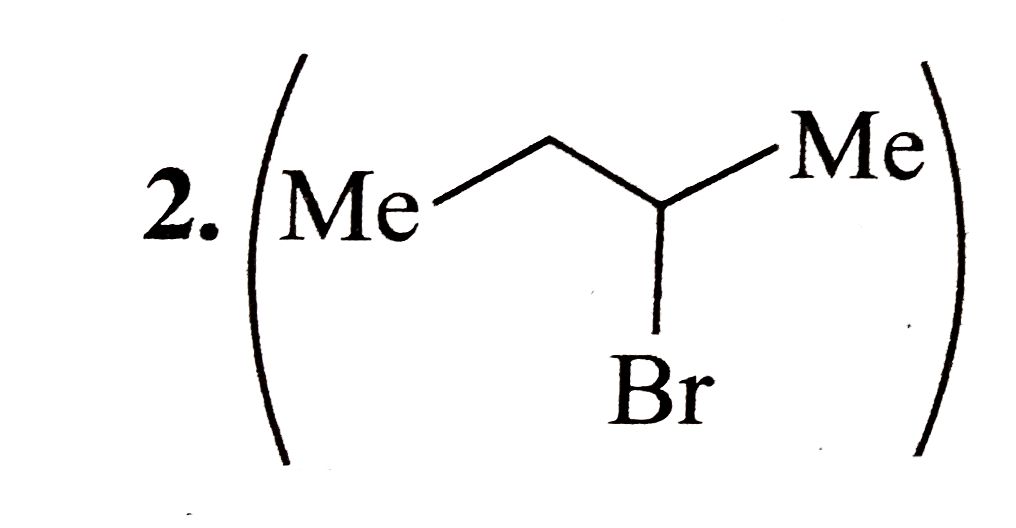Isopropyl chloride undergoes hydrolysis by :
SN 1 mechanism
SN 2 mechanism
SN1andSN 2 mechanism
neither SN 1 nor SN 2 mechanism
The correct Answer is:C
To determine how isopropyl chloride undergoes hydrolysis, we need to analyze the mechanisms involved. Here’s a step-by-step solution:
Step 1: Identify Isopropyl Chloride
Isopropyl chloride is a haloalkane with the chemical formula C3H7Cl or CH3CHClCH3.
Hint: Recognize the structure of isopropyl chloride to understand its reactivity.
Step 2: Understand Hydrolysis Mechanisms
Hydrolysis can occur through two main mechanisms: SN1 and SN2.
- SN1 Mechanism: This is a unimolecular nucleophilic substitution that involves two steps:
1. Formation of a carbocation after the leaving group departs.
2. Nucleophilic attack on the carbocation.
- SN2 Mechanism: This is a bimolecular nucleophilic substitution that occurs in one step:
1. The nucleophile attacks the substrate as the leaving group departs, forming a transition state.
Hint: Differentiate between SN1 and SN2 based on the number of steps and the order of kinetics.
Step 3: Analyze the Reaction Pathways
1. SN1 Pathway:
- The chloride ion (Cl-) leaves, forming a secondary carbocation.
- The nucleophile (usually water, H2O) then attacks the carbocation to form isopropyl alcohol (CH3CHOHCH3).
2. SN2 Pathway:
- The nucleophile (water) attacks the carbon atom bonded to the chlorine while the chlorine leaves simultaneously.
- This also leads to the formation of isopropyl alcohol.
Hint: Visualize the steps to see how the nucleophile interacts with the substrate.
Step 4: Determine the Rate of Reaction
- In the SN1 mechanism, the rate of reaction depends only on the concentration of isopropyl chloride (the substrate).
- In the SN2 mechanism, the rate depends on the concentration of both isopropyl chloride and the nucleophile.
Hint: Recall that SN1 is first-order and SN2 is second-order in terms of kinetics.
Step 5: Conclusion
Isopropyl chloride can undergo hydrolysis through both SN1 and SN2 mechanisms, resulting in the same product (isopropyl alcohol). Therefore, the correct answer is that isopropyl chloride undergoes hydrolysis by both mechanisms.
Final Answer: Isopropyl chloride undergoes hydrolysis by both SN1 and SN2 mechanisms.
---
Isopropyl chloride is a haloalkane with the chemical formula C3H7Cl or CH3CHClCH3.
Hydrolysis can occur through two main mechanisms: SN1 and SN2.
1. Formation of a carbocation after the leaving group departs.
2. Nucleophilic attack on the carbocation.
1. The nucleophile attacks the substrate as the leaving group departs, forming a transition state.
1. SN1 Pathway:
- The chloride ion (Cl-) leaves, forming a secondary carbocation.
- The nucleophile (usually water, H2O) then attacks the carbocation to form isopropyl alcohol (CH3CHOHCH3).
- The nucleophile (water) attacks the carbon atom bonded to the chlorine while the chlorine leaves simultaneously.
- This also leads to the formation of isopropyl alcohol.
- In the SN1 mechanism, the rate of reaction depends only on the concentration of isopropyl chloride (the substrate).
- In the SN2 mechanism, the rate depends on the concentration of both isopropyl chloride and the nucleophile.
Isopropyl chloride can undergo hydrolysis through both SN1 and SN2 mechanisms, resulting in the same product (isopropyl alcohol). Therefore, the correct answer is that isopropyl chloride undergoes hydrolysis by both mechanisms.
Topper's Solved these Questions
- HALOALKANES & HALOARENES BOOK - VMC MODULES ENGLISHCHAPTER - HALOALKANES & HALOARENES EXERCISE - EFFICIENT
100 Videos
- HALOALKANES & HALOARENES BOOK - VMC MODULES ENGLISHCHAPTER - HALOALKANES & HALOARENES EXERCISE - IMPECCABLE
100 Videos
- HALOALKANES & HALOARENES BOOK - VMC MODULES ENGLISHCHAPTER - HALOALKANES & HALOARENES EXERCISE - IMPECCABLE
100 Videos
- ENVIRONMENTAL CHEMISTRYBOOK - VMC MODULES ENGLISHCHAPTER - ENVIRONMENTAL CHEMISTRYEXERCISE - JEE Main (Archive)
39 Videos
- HALOALKANES AND HALOARENESBOOK - VMC MODULES ENGLISHCHAPTER - HALOALKANES AND HALOARENESEXERCISE - IN-CHAPTER EXERCISE - F
6 Videos
Similar Questions
Knowledge Check
Which of the following alkyl halides undergoes hydrolysis with aqueous KOH at the fastest rate ?
ACH3CH2CH2ClBCH3CH2ClCCH3CH2CH2CH2ClDCH3CH2CH(Br)CH3
Silicon tetrachloride undergoes hydrolysis to form silicic acid.
View Solution (sec-Butyl bromide) undergoes alkaline hydrolysis by :
(sec-Butyl bromide) undergoes alkaline hydrolysis by :
View Solution (sec-Butyl bromide) undergoes alkaline hydrolysis by :
(sec-Butyl bromide) undergoes alkaline hydrolysis by :
View SolutionWhat single isomer would be found in greatest yeild when isopropyl chloride undergoes a Friedel-Crafts alklyation with t-butylbenzene?
View SolutionWhich of the following halide undergoes in hydrolysis via SN1 reaction?
View SolutionPhosphorus trichloride, PCl3 undergoes, hydrolysis at room temperature to produce an oxoacid. It has the formula :
View SolutionWhich one of the following tetrachlorides does not undergo
hydrolysis ?
View Solution
